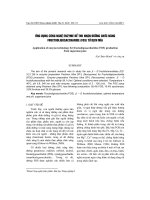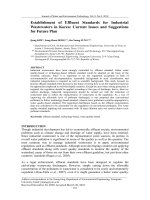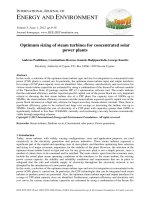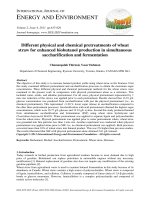regularity of random attractors for stochastic semilinear degenerate parabolic equations
Bạn đang xem bản rút gọn của tài liệu. Xem và tải ngay bản đầy đủ của tài liệu tại đây (130.61 KB, 9 trang )
J. Math. Anal. Appl. 329 (2007) 1036–1044
www.elsevier.com/locate/jmaa
Attracting and invariant sets for a class of impulsive
functional differential equations ✩
Daoyi Xu a , Zhichun Yang a,b,∗
a Mathematical College, Sichuan University, Chengdu 610064, PR China
b Mathematical College, Chongqing Normal University, Chongqing 400047, PR China
Received 28 June 2005
Available online 8 August 2006
Submitted by K. Gopalsamy
Abstract
In this article, a class of nonlinear and nonautonomous functional differential systems with impulsive
effects is considered. By developing a delay differential inequality, we obtain the attracting set and invariant
set of the impulsive system. An example is given to illustrate the theory.
© 2006 Elsevier Inc. All rights reserved.
Keywords: Attracting set; Invariant set; Stability; Impulsive differential equation; Differential inequality
1. Introduction
Impulsive differential equations have attracted increasing interest both in theoretical research
and applications in the past 20 years. In particular, the stability of the zero solution of impulsive differential equations has recently been widely studied by many authors (see [1–10]).
However, under impulsive perturbation, the equilibrium point sometimes does not exist in many
real physical systems, especially in nonlinear and nonautonomous dynamical systems. Therefore,
an interesting subject is to discuss the attracting set and the invariant set of impulsive systems.
Some significant progress has been made in the techniques and methods of determining the
invariant set and attracting set for the continuous differential systems including ordinary differ✩
The work is supported by National Natural Science Foundation of China under Grant 10371083.
* Corresponding author.
E-mail address: (Z. Yang).
0022-247X/$ – see front matter © 2006 Elsevier Inc. All rights reserved.
doi:10.1016/j.jmaa.2006.05.072
D. Xu, Z. Yang / J. Math. Anal. Appl. 329 (2007) 1036–1044
1037
ential equations, partial differential equations and delay differential equations and so on [11–18].
Unfortunately, the corresponding problems for impulsive functional differential equations have
not been considered prior to this work.
Motivated by the above discussions, our objective in this paper is to determine the invariant set
and the global attracting set for a class of nonlinear nonautonomous functional differential systems with impulsive effects. Our method is based on a differential inequality with the impulsive
initial conditions. An example is given to illustrate our results.
2. Preliminaries
Let N be the set of all positive integers, R n be the space of n-dimensional real column vectors
and R m×n be the set of m × n real matrices. E denotes an n × n unit matrix. For A, B ∈ R m×n
or A, B ∈ R n , A B (A B, A > B, A < B) means that each pair of corresponding elements
of A and B satisfies the inequality “ ( , >, <)”. Especially, A is called a nonnegative matrix
if A 0, and z is called a positive vector if z > 0.
For x(t) = (x1 (t), . . . , xn (t))T : R → R n , we define
x(t + s) − x(t)
,
D + x(t) = lim sup
s
+
s→0
x(t + ) = lim x(t + s),
x(t − ) = lim x(t + s),
x(t)
x(t)
+
τ
s→0+
s→0−
= x1 (t) , . . . , xn (t)
=
x1 (t) τ , . . . , xn (t)
T
,
xi (t)
T
τ
and
τ
=
x(t)
sup xi (t + s)
−τ s 0
+
+
= x(t) τ .
τ
,
Let τ > 0 and t0 < t1 < t2 < · · · be the fixed points with limk→∞ tk = ∞ (called impulsive
moments).
C[X, Y ] denotes the space of continuous mappings from the topological space X to the topological space Y . Especially, let C = C[[−τ, 0], R n ].
PC={φ : [−τ, 0] → R n | φ(t + ) = φ(t) for t ∈ [−τ, 0), φ(t − ) exists for t ∈ (−τ, 0],
φ(t − ) = φ(t) for all but at most a finite number of points t ∈ (−τ, 0]}. PC is a space of piecewise
right-hand continuous functions with the norm φ = sup−τ s 0 |φ(s)|, φ ∈ PC, where | · | is a
norm in R n .
PC[[t0 , ∞), R m×n ] = {ψ : [t0 , ∞) → R m×n | ψ(t) is continuous at t = tk , ψ(tk+ ) and ψ(tk− )
exist, ψ(tk ) = ψ(tk+ ), for k ∈ N}.
In this paper, we shall consider an impulsive functional differential equation
x(t)
˙ = A(t)x(t) + f (t, xt ),
t = tk , t
x = x tk+ − x tk− = Ik x tk− ,
t0 ,
k ∈ N,
(1)
where A(t) ∈ PC[[t0 , ∞), R n×n ], f ∈ C[[tk−1 , tk ) × PC, R n ] and the limit
lim
(t,φ)→(tk− ,ϕ)
f (t, φ) = f tk− , ϕ
˙
denotes the
exists, Ik ∈ C[R n , R n ], xt ∈ PC is defined by xt (s) = x(t + s), s ∈ [−τ, 0], x(t)
right-hand derivative of x(t).
Definition 1. A function x(t) : [t0 − τ, ∞) → R n is said to be a solution of (1) through (t0 , φ), if
x(t) ∈ PC[[t0 , ∞), R n ] as t t0 , and satisfies (1) with the initial condition
x(t0 + s) = φ(s),
s ∈ [−τ, 0], φ ∈ PC.
1038
D. Xu, Z. Yang / J. Math. Anal. Appl. 329 (2007) 1036–1044
Throughout the paper, we always assume that for any φ ∈ PC, system (1) has at least one
solution through (t0 , φ), denoted by x(t, t0 , φ) or xt (t0 , φ) (simply x(t) and xt if no confusion
should occur), where xt (t0 , φ) = x(t + s, t0 , φ) ∈ PC, s ∈ [−τ, 0].
Definition 2. The set S ⊂ PC is called a positive invariant set of (1), if for any initial value φ ∈ S,
we have the solution xt (t0 , φ) ∈ S for t t0 .
Definition 3. The set S ⊂ PC is called a global attracting set of (1), if for any initial value φ ∈ PC,
the solution xt (t0 , φ) converges to S as t → +∞. That is,
dist(xt , S) → 0 as t → +∞,
where dist(ϕ, S) = infψ∈S dist(ϕ, ψ), dist(ϕ, ψ) = sups∈[−τ,0] |ϕ(s) − ψ(s)|, for ϕ ∈ PC.
Definition 4. The zero solution of (1) is said to be globally exponentially stable if for any solution
x(t, t0 , φ), there exist constants λ > 0 and κ 1 such that
x(t, t0 , φ)
κ φ e−λ(t−t0 ) ,
t
t0 .
0, i = j ,
Definition 5. [21,22] Let the matrix D = (dij )n×n with dii > 0 and dij
i, j = 1, 2, . . . , n. Then each of the following conditions is equivalent to the statement “D is
a nonsingular M-matrix”:
(i)
(ii)
(iii)
(iv)
All the leading principle minors of D are positive.
D −1 exists and D −1 0.
There exists a positive vector d such that Dd > 0 or D T d > 0.
D = C − M and ρ(C −1 M) < 1, where M 0, C = diag{c1 , . . . , cn } and ρ(·) is the spectral
radius of the matrix.
Based on Halanay inequality [19] and its extension [10,20], we develop the following differential inequality with the impulsive initial condition.
Lemma 1. Let σ < b
+∞ and v(t) ∈ C[[σ, b), R n ] satisfies
D + v(t) P v(t) + Q v(t)
v(σ + s) ∈ PC,
τ
+ J, t ∈ [σ, b),
s ∈ [−τ, 0],
(2)
0 for i = j , Q = (qij )n×n
0 and J = (J1 , . . . , Jn )T
0,
where P = (pij )n×n , pij
i, j = 1, 2, . . . , n. Suppose that there exist a scalar λ > 0 and a vector z = (z1 , z2 , . . . , zn )T > 0
such that
λE + P + Qeλτ z < 0.
(3)
If the initial condition satisfies
v(t)
then v(t)
κze−λ(t−σ ) − (P + Q)−1 J,
κze−λ(t−σ )
− (P
+ Q)−1 J
κ
0, t ∈ [σ − τ, σ ],
(4)
for t ∈ [σ, b).
Proof. From (3), we have (P + Q)z < 0. Together with Definition 5 and the negativeness of
nondiagonal entries of P + Q, this implies that −(P + Q)−1 exists and −(P + Q)−1 0.
Denote
u(t) = u1 (t), . . . , un (t)
T
= v(t) + (P + Q)−1 J,
t ∈ [σ − τ, b).
D. Xu, Z. Yang / J. Math. Anal. Appl. 329 (2007) 1036–1044
1039
Then, by (2) and (4),
D + u(t)
P v(t) + Q v(t)
τ
+J
P u(t) − (P + Q)−1 J + Q u(t) − (P + Q)−1 J
= P u(t) + Q u(t) τ , t ∈ [σ, b),
τ
+J
(5)
and
u(t)
κze−λ(t−σ ) ,
κ
0, t ∈ [σ − τ, σ ].
(6)
In the following, we shall prove that for any positive constant
ui (t)
(κ + )zi e−λ(t−σ ) = yi (t),
t ∈ [σ, b), i = 1, . . . , n.
(7)
If this is not true, from (6) and the continuity of u(t) as t ∈ [σ, b), then there must be a constant
t ∗ > σ and some integer m such that
D + um (t ∗ ) y˙m (t ∗ ),
um (t ∗ ) = ym (t ∗ ),
ui (t) yi (t), t ∈ [σ − τ, t ∗ ], i = 1, . . . , n.
Using (5), (7)–(9), pij
n
D + um (t ∗ )
j =1
n
j =1
n
=
0 (i = j ) and Q
0, we obtain that
pmj uj (t ∗ ) + qmj uj (t ∗ )
pmj (κ + )zj e−λ(t
(8)
(9)
∗ −σ )
τ
+ qmj (κ + )zj e−λ(t
pmj + qmj eλτ zj (κ + )e−λ(t
∗ −σ )
∗ −τ −σ )
.
(10)
j =1
From (3), we have
n
j =1 [pmj
+ qmj eλτ ]zj < −λzm . Then (10) becomes
D + um (t ∗ ) < −λzm (κ + )e−λ(t
∗ −σ )
= y˙m (t ∗ ).
This contradicts the inequality in (8), and so (7) holds. Letting → 0+ in (7), we have
u(t) = v(t) + (P + Q)−1 J
The proof is complete.
κze−λ(t−σ ) ,
t ∈ [σ, b).
✷
3. Main results
In this paper, we always suppose the following.
(A1) [f (t, ϕ)]+
B[ϕ]+
t0 and ϕ ∈ PC, where B = (bij )n×n
τ + J for t
J = (J1 , J2 , . . . , Jn )T 0.
(A2) There exist a scalar λ > 0 and a vector z = (z1 , z2 , . . . , zn )T > 0 such that
0 and
λE + A¯ + Beλτ z < 0,
where A¯ = (a¯ ij )n×n satisfies aii (t) a¯ ii < 0 and |aij (t)| a¯ ij for i = j , i, j = 1, 2, . . . , n.
(k)
(A3) [x + Ik (x)]+ Γk [x]+ , k ∈ N , for any x ∈ R n , where Γk = (γij )n×n 0.
1040
D. Xu, Z. Yang / J. Math. Anal. Appl. 329 (2007) 1036–1044
Theorem 1. Assume that (A1)–(A3) hold. If
∞
λ(tk − tk−1 )
ln μk
and ν =
ln νk < ∞,
k ∈ N,
(11)
νk (−A¯ − B)−1 J,
(12)
k=1
where μk , νk
Γk z
1 satisfy
and Γk (−A¯ − B)−1 J
μk z
then S = {φ ∈ PC | [φ]+
τ
eν (−A¯ − B)−1 J } is a global attracting set of (1).
¯ we calculate the upper right derivative along the
Proof. From (A1) and the definition of A,
solutions of (1),
D + xi (t) = sgn xi (t) x˙i (t)
n
aij (t)xj (t) + fi (t, xt )
sgn xi (t)
j =1
n
aii (t) xi (t) +
aij (t) xj (t) +
j =i
bij xj (t)
j =1
n
a¯ ii xi (t) +
a¯ ij xj (t) +
j =i
bij xj (t)
j =1
+
τ
+
τ
+ Ji
+ Ji ,
i = 1, 2, . . . , n,
where sgn(·) is the sign function. That is,
D + x(t)
+
A¯ x(t)
+
+ B x(t)
+
τ
+ J,
t ∈ [tk−1 , tk ), k ∈ N.
(13)
From (A2) and Definition 5, we have (A¯ + B)z < 0 and −(A¯ + B) is an M-matrix. Then
−(A¯ + B)−1 0, and so w = −(A¯ + B)−1 J 0. Furthermore, we can find an enough small
> 0 such that
(λ + )E + A¯ + Be(λ+
)τ
z < 0.
(14)
For the initial conditions x(t0 + s) = φ(s), s ∈ [−τ, 0], where φ ∈ PC, we have
x(t)
+
κ0 z,
κ0 =
φ
min1
i n {zi }
, t0 − τ
t
t0 ,
and so
x(t)
+
κ0 ze−(λ+
)(t−t0 )
+ w,
t0 − τ
+ w,
t0
t
(15)
t0 .
By (13)–(15) and Lemma 1,
x(t)
+
κ0 ze−(λ+
)(t−t0 )
(16)
t < t1 .
Suppose that for all m = 1, . . . , k the inequalities
x(t)
+
μ0 · · · μm−1 κ0 ze−(λ+
)(t−t0 )
+ ν0 · · · νm−1 w,
hold, where μ0 = ν0 = 1. Then, from (A3), (12) and (17),
tm−1
t < tm ,
(17)
D. Xu, Z. Yang / J. Math. Anal. Appl. 329 (2007) 1036–1044
x(tk )
+
+
= x tk− + Ik x tk−
Γk μ0 · · · μk−1 κ0 ze−(λ+
μ0 · · · μk−1 μk κ0 ze
+
)(tk −t0 )
−(λ+ )(tk −t0 )
+ ν0 · · · νk−1 w
+ ν0 · · · νk−1 νk w.
(18)
1, lead to
This, together with (17) and μk , νk
x(t)
1041
μ0 · · · μk−1 μk κ0 ze−(λ+
)(t−t0 )
+ ν0 · · · νk−1 νk w
for t ∈ [tk − τ, tk ].
(19)
On the other hand,
D + x(t)
+
A¯ x(t)
+
+
τ
+ B x(t)
+ ν0 ν1 · · · νk J,
t = tk .
(20)
It follows from (14), (19), (20) and Lemma 1 that
+
x(t)
μ0 · · · μk−1 μk κ0 ze−(λ+
)(t−t0 )
+ ν0 · · · νk−1 νk w
for t ∈ [tk , tk+1 ).
(21)
By the induction, we can conclude that
+
x(t)
μ0 · · · μk−1 κ0 ze−(λ+
+ ν0 · · · νk−1 w,
)(t−t0 )
tk−1
t < tk , k ∈ N.
(22)
From (11),
μk
eλ(tk −tk−1 ) ,
ν0 · · · νk−1
eν ,
we can use (22) to conclude that
x(t)
+
eλ(t1 −t0 ) · · · eλ(tk−1 −tk−2 ) κ0 ze−(λ+
κ0 ze
= κ0 ze
λ(t−t0 ) −(λ+ )(t−t0 )
e
− (t−t0 )
+e w
ν
)(t−t0 )
+ ν0 · · · νk−1 w
+e w
ν
for all t ∈ [t0 , tk ), k ∈ N.
This implies that the conclusion holds and the proof is complete.
✷
Remark 1. In condition (A2), λ and z are easily found if −(A¯ + B) is an M-matrix. In fact, from
(iii) in Definition 5, there exists a positive vector z such that −(A¯ + B)z > 0. Then, by using
continuity, there is a λ satisfying (A2).
By using Lemma 1 with κ0 = 0, we can obtain a positive invariant set of (1).
Theorem 2. Assume that (A1)–(A3) with Γk = E hold. Then S = {φ ∈ PC | [φ]+
τ
(−A¯ − B)−1 J } is a positive invariant set and also a global attracting set of (1).
Proof. Similarly, the inequality (14) holds by (A1). For the initial condition x(t0 + s) = φ(s),
s ∈ [−τ, 0], where φ ∈ S, we have
x(t)
+
(−A¯ − B)−1 J,
t0 − τ
t
(23)
t0 .
By (A2), (14), (23) and Lemma 1 with κ = 0,
x(t)
+
(−A¯ − B)−1 J,
t0
t < t1 .
Also,
x t1+
+
= x t1− + Ik x t1−
+
x t1−
+
(−A¯ − B)−1 J.
1042
D. Xu, Z. Yang / J. Math. Anal. Appl. 329 (2007) 1036–1044
Thus,
x(t)
+
(−A¯ − B)−1 J,
t1 − τ
t
t1 .
Using Lemma 1 again, we obtain
x(t)
+
(−A¯ − B)−1 J,
t1
t < t2 .
By an induction, we have
x(t)
+
(−A¯ − B)−1 J,
tk−1
t < tk , k ∈ N.
Therefore, S = {φ ∈ PC | [φ]+
(−A¯ − B)−1 J } is a positive invariant set. Since Γk = E, a diτ
rect calculation shows that μk = νk = 1 and ν = 1 in Theorem 1. It follows from Theorem 1 that
the set S is also a global attracting set of (1). The proof is complete. ✷
For the case J = 0, we easily observe x(t) = 0 is a solution of (1) from (A1) and (A3).
In the following, we give the attractivity of the zero solution and the proof is similar to that of
Theorem 1.
Theorem 3. Assume that (A1)–(A3) with J = 0 hold. If
ln μk
λ(tk − tk−1 ),
where μk
μk z, k ∈ N,
1 satisfy Γk z
then the zero solution of (1) is globally exponentially stable.
Remark 2. According to the properties of M-matrix given in Definition 5, one can see that the
above theorems are extension and improvement of the results on continuous dynamical systems
in [17,18].
4. Illustrative example
Example 1. Consider a 2-dimensional impulsive delay system
⎧
⎪
⎪ x˙1 (t) = −4x1 (t) + sin(t)x2 (t) + sin x1 (t − 1) + x2 (t − 1) + J1 (t), t 0,
⎪
⎪
⎨ x˙2 (t) = cos(t)x1 (t) − 4x2 (t) − x1 (t − 1) + sin x2 (t − 1) + J2 (t), t = tk ,
⎪
x1 = x1 tk+ − x1 tk− = I1 x tk− ,
⎪
⎪
⎪
⎩
x2 = x2 tk+ − x2 tk− = I2 x tk− ,
tk = k,
(24)
k ∈ N,
where J (t) = (J1 (t), J2 (t))T with |J1 (t)| J1 and |J2 (t)| J2 , Ik (x) = (β1k x1 , β2k x2 )T . Taking τ = 1, λ = 0.3, z = (1, 1)T , we easily verify the conditions (A1)–(A3) with
A¯ =
Γk =
−4 1
1 −4
|1 + β1k |
0
B=
,
0
|1 + β2k |
λE + A¯ + eλτ B z ≈
1 1
1 1
,
J1
J2
J=
,
,
−2.3501 2.3499
2.3499 −2.3501
1
1
=
−0.0002
−0.0002
Now, we discuss the asymptotical behavior of the system (24) as follows:
< 0.
D. Xu, Z. Yang / J. Math. Anal. Appl. 329 (2007) 1036–1044
1
(i) If J (t) = (sin(t), cos(t))T and −e 4k − 1
1
1
βik
1043
1
e 4k − 1, i = 1, 2, k ∈ N , then Γk = e 4k E
and J = (1, 1)T . Thus, μk = νk = e 4k and ν = 13 , which implies that the conditions (11) and (12)
1
1
1
e 3 (−A¯ − B)−1 J = (e 3 , e 3 )T } is a global
hold. Therefore, by Theorem 1, S = {φ ∈ PC | [φ]+
τ
attracting set of (24).
(ii) If J (t) = (4 cos(t), 5 sin(t))T and −2 βik 0, i = 1, 2, then Γk = E and J = (4, 5)T .
According to Theorem 2, S = {φ ∈ PC | [φ]+
w = (−A¯ − B)−1 J = (4.4, 4.6)T } is a positive
τ
invariant set and also a global attracting set of (24).
(iii) If J (t) = (0, 0)T and −2.3 βik 0.3, i = 1, 2, then Γk = 1.3E and x = (0, 0)T is the
solution of (24). Taking μk = 1.3, it follows from Theorem 3 that the zero solution of (24) is
globally exponentially stable.
Acknowledgments
The authors are thankful to the reviewers for their encouragements and helpful suggestions as well as detailed annotations.
References
[1] V. Lakshmikantham, D.D. Bainov, P.S. Simeonov, Theory of Impulsive Differential Equations, World Scientific,
Singapore, 1989.
[2] D.D. Bainov, P.S. Simeonov, Systems with Impulse Effect: Stability Theory and Applications, Ellis Horwood Limited, Chichester, 1989.
[3] K. Gopalsamy, B.G. Zhang, On delay differential equation with impulses, J. Math. Anal. Appl. 139 (1989) 110–122.
[4] A. Anokhin, L. Berezansky, E. Braverman, Exponential stability of linear delay impulsive differential equations,
J. Math. Anal. Appl. 193 (1995) 923–941.
[5] J. Yan, Stability theorems of perturbed linear system with impulse effect, Port. Math. 53 (1996) 43–51.
[6] J.H. Shen, Razumikhin techniques in impulsive functional differential equations, Nonlinear Anal. 36 (1999) 119–
130.
[7] M.U. Akhmetov, A. Zafer, Stability of the zero solution of impulsive differential equations by the Lyapunov second
method, J. Math. Anal. Appl. 248 (2000) 69–82.
[8] X. Liu, G. Ballinger, Uniform asymptotic stability of impulsive delay differential equations, Comput. Math. Appl. 41
(2001) 903–915.
[9] J.S. Yu, Stability for nonlinear delay differential equations of unstable type under impulsive perturbations, Appl.
Math. Lett. 14 (2001) 849–857.
[10] D. Xu, Z. Yang, Impulsive delay differential inequality and stability of neural networks, J. Math. Anal. Appl. 305
(2005) 107–120.
[11] K. Sawano, Positively invariant sets for functional differential equations with infinite delay, Tôhoku Math. J. 32
(1980) 557–566.
[12] G. Seifert, Positively invariant closed sets for systems of delay differential equations, J. Differential Equations 22
(1976) 292–304.
[13] D.D. Siljak, Large-Scale Dynamic System: Stability and Structure, Elsevier, North-Holland, 1978.
[14] V. Lakshmikantham, S. Leela, Differential and Integral Inequalities, vol. I, Academic Press, New York, 1969.
[15] A.V. Razgulin, The attractor of the delayed functional-differential diffusion equation. Numerical methods in mathematical physics, Comput. Math. Model. 8 (1997) 181–186.
[16] D. Xu, S. Li, X. Zhou, Z. Pu, Invariant set and stable region of a class of partial differential equations with time
delays, Nonlinear Anal. Real World Appl. 2 (2001) 161–169.
[17] D. Xu, H. Zhao, Invariant and attracting sets of Hopfield neural networks with delay, Internat. J. Systems Sci. 32
(2001) 863–866.
[18] H. Zhao, Invariant set and attractor of nonautonomous functional differential systems, J. Math. Anal. Appl. 282
(2003) 437–443.
[19] A. Halanay, Differential Equations: Stability, Oscillations, Time Lages, Academic Press, New York, 1966.
1044
D. Xu, Z. Yang / J. Math. Anal. Appl. 329 (2007) 1036–1044
[20] K. Gopalsamy, Stability and Oscillations in Delay Differential Equations of Population Dynamics, Kluwer, Dordrecht, 1992.
[21] A. Berman, R.J. Plemmons, Nonnegative Matrices in Mathematical Sciences, Academic Press, New York, 1979.
[22] R.A. Horn, C.R. Johnson, Matrix Analysis, Cambridge University Press, 1985.









